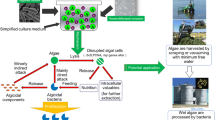Abstract
Objectives
To biochemically characterize synthetic peptides to control harmful algal blooms (HABs) that cause red tides in marine water ecosystems.
Results
We present an analysis of several short synthetic peptides and their efficacy as algicidal agents. By altering the amino acid composition of the peptides we addressed the mode of algicidal action and determine the optimal balance of cationic and hydrophobic content for killing. In a controlled setting, these synthetic peptides disrupted both plasma and chloroplast membranes of several species known to result in HABs. This disruption was a direct result of the hydrophobic and cationic content of the peptide. Furthermore, by using an anti-HAB bioassay in scallops, we determined that these peptides were algicidal without being cytotoxic to other marine organisms.
Conclusions
These synthetic peptides may prove promising for general marine ecosystem remediation where HABs have become widespread and resulted in serious economic loss.




Similar content being viewed by others
References
Anderson DM, Cembella AD, Hallegraeff GM (2012) Progress in understanding harmful algal blooms: paradigm shifts and new technologies for research, monitoring, and management. Ann Rev Mar Sci 4:143–176
Gibbs SP (1981) The chloroplasts of some algal groups may have evolved from endosymbiotic eukaryotic algae. Ann NY Acad Sci 361:193–208
Hoagland P, Jin D, Polansky LY, Kirkpatrick B, Kirkpatrick G, Fleming LE, Reich A, Watkins SM, Ullmann SG, Backer LC (2009) The costs of respiratory illnesses arising from Florida gulf coast Karenia brevis blooms. Environ Health Perspect 117:1239–1243
Jeffrey SW, Humphrey GF (1975) New spectrophotometric equations for determining chlorophyll a, b, c1 and c2 in higher plants, algae and natural phytoplankton. Biochem Physiol Pflanz 167:191–194
Kennedy SM, Aiken EJ, Beres KA, Hahn AR, Kamin SJ, Hagness SC, Booske JH, Murphy WL (2014) Cationic peptide exposure enhances pulsed-electric-field-mediated membrane disruption. PLoS One 9:e92528
Kim D-K, Okamoto T, Oda T, Tachibana K, Lee KS, Ishimatsu A, Matsuyama Y, Honjo T, Muramatsu T (2001) Possible involvement of glycocalyx in the ichthyotoxicity of Chattonella marina (Raphidophyceae): immunological approach using antiserum against cell surface structures of the flagellate. Mar Biol 139:625–632
Kim YS, Lee DS, Jeong SY, Lee WJ, Lee MS (2009) Isolation and characterization of a marine algicidal bacterium against the harmful raphidophyceae Chattonella marina. J Microbiol 47:9–18
Kim YM, Kim NH, Lee JW, Jang JS, Park YH, Park SC, Jang MK (2015) Novel chimeric peptide with enhanced cell specificity and anti-inflammatory activity. Biochem Biophys Res Commun 463:322–328
Kirkpatrick B, Fleming LE, Bean JA, Nierenberg K, Backer LC, Cheng YS, Pierce R, Reich A, Naar J, Wanner A et al (2011) Aerosolized red tide toxins (Brevetoxins) and asthma: continued health effects after 1 hour beach exposure. Harmful Algae 10:138–143
Landsberg JH (2002) The effects of harmful algal blooms on aquatic organisms. Rev Fish Sci 10:113–390
Lee YS, Kim JD, Lim WA, Lee SG (2009) Survival and growth of Cochlodinium polykrikoides red tide after addition of yellow loess. J Environ Biol 30:929–932
Marshall J-A, Nichols PD, Hallegraeff GM (2002) Chemotaxonomic survey of sterols and fatty acids in six marine raphidophyte algae. J Appl Phycol 14:255–265
McIntyre L, Cassis D, Haigh N (2013) Formation of a volunteer harmful algal bloom network in British Columbia, Canada, following an outbreak of diarrhetic shellfish poisoning. Mar Drugs 11:4144–4157
Park SC, Kim MH, Hossain MA, Shin SY, Kim Y, Stella L, Wade JD, Park Y, Hahm KS (2008) Amphipathic alpha-helical peptide, HP (2-20), and its analogues derived from Helicobacter pylori: pore formation mechanism in various lipid compositions. Biochim Biophys Acta 1778:229–241
Park SC, Lee JK, Kim SW, Park Y (2011) Selective algicidal action of peptides against harmful algal bloom species. PLoS One 6:e26733
Park TG, Lim WA, Park YT, Lee CK, Jeong HJ (2013) Economic impact, management and mitigation of red tides in Korea. Harmful Algae 30:S131–S143
Parrish CC (1988) Dissolved and particulate marine lipid classes: a review. Mar Chem 23:17–40
Sato N, Hagio M, Wada H, Tsuzuki M (2000) Environmental effects on acidic lipids of thylakoid membranes. Biochem Soc Trans 28:912–914
Wada H, Murata N (2007) The essential role of phosphatidylglycerol in photosynthesis. Photosynth Res 92:205–215
Wu L, Wu H, Chen L, Xie S, Zang H, Borriss R, Gao X (2014) Bacilysin from Bacillus amyloliquefaciens FZB42 has specific bactericidal activity against harmful algal bloom species. Appl Environ Microbiol 80:7512–7520
Acknowledgments
This research was supported by the National Institute of Ecology (NIE) and the Ministry of Education, Science, and Technology (NRF-2013R1A1A4A01010701).
Author information
Authors and Affiliations
Corresponding authors
Additional information
Seong-Chol Park and Jeong Chan Moon have contributed equally to this work.
Rights and permissions
About this article
Cite this article
Park, SC., Moon, J.C., Kim, NH. et al. Algicidal effect of hybrid peptides as potential inhibitors of harmful algal blooms. Biotechnol Lett 38, 847–854 (2016). https://doi.org/10.1007/s10529-016-2052-0
Received:
Accepted:
Published:
Issue Date:
DOI: https://doi.org/10.1007/s10529-016-2052-0




